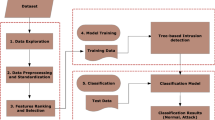Abstract
Due to rapid growth of communications and networks, a cyber-attack with malicious codes has been coming as a new paradigm in information security area since last few years. In particular, an advanced persistent threats (APT) attack is bringing out big social issues. The APT attack uses social engineering methods to target various systems for intrusions. It breaks down the security of the target system to leak information or to destroy the system by giving monetary damages on the target. APT attacks make relatively simple attacks such as spear phishing during initial intrusion but a back door is created by leaking the long-term information after initial intrusion, and it transmits the malicious code by analyzing the internal network. In this paper, we propose an intrusion detection system based on the decision tree using analysis of behavior information to detect APT attacks that intellectually change after intrusion into a system. Furthermore, it can detect the possibility on the initial intrusion and minimize the damage size by quickly responding to APT attacks.



Similar content being viewed by others
References
Nikos V, Gritzalis D, Apostolopoulos T (2013) Trusted Computing vs. advanced persistent threats: can a defender win this game?. In: Ubiquitous Intelligence and Computing, 2013 IEEE 10th international conference on and 10th international conference on autonomic and trusted computing (UIC/ATC). IEEE, pp 396–403
Nikos V, Gritzalis D (2013) The big four-what we did wrong in advanced persistent threat detection?. In: Availability, Reliability and Security (ARES), 2013 Eighth International Conference on. IEEE
Seresht NA, Azmi R. MAIS-IDS: a distributed intrusion detection system using multi-agent AIS approach. Eng Appl Artif Intell 35:286–298
Hung-Jen L, Lin C-HR, Lin Y-C, Tung K-Y (2013) Intrusion detection system: A comprehensive. J Netw Comput Appl 36(1):16–24
Gaur Madhu Sharma, Pant Bhaskar (2015) Trusted and secure clustering in mobile pervasive environment. Human-centric Comput Inf Sci 5(32):19
Kang H-S (2015) A real-time integrated hierarchical temporal memory network for the real-time continuous multi-interval prediction of data streams. J Inf Process Syst 11(1):39–56
Falliere N, Murchu Liam O, Chien E (2011) W32.Stuxnet Dossier Version 1.4 (February 2011). Symantec Corporation
Bencsáth B, Pék G, Buttyán L, Félegyházi M (2012) Duqu: analysis, detection, and lessons learned. ACM Eur Workshop Syst Secur (EuroSec) 2012
(2013) The ‘Red October’ Campaign—an advanced cyber espionage network targeting diplomatic and government agencies. GReAT, Kaspersky Lab
(2015) CARBANAK APT THE GREAT BANK ROBBERY”, Version 2.1. Kaspersky lab
Modi C, Patel D, Borisaniya B, Patel H, Patel Avi, Rajarajan Muttukrishnan (2013) A survey of intrusion detection techniques in Cloud. J Netw Comput Appl 36(1):42–57
Nissim N, Moskovitch R, Rokach L, Elovici Y (2014) Novel active learning methods for enhanced PC malware detection in windows OS. Expert Syst Appl 41(13):5843–5857
Ahn Hosang, Kim Hanna, Park Jae Roh (2014) Smart Monitoring of indoor asbestos based on the distinct optical properties of asbestos from particulate matters. J Converg 5(4):11–14
Pradhan B (2013) A comparative study on the predictive ability of the decision tree, support vector machine and neuro-fuzzy models in landslide susceptibility mapping using GIS. Comput Geosci 51:350–365
Jidiga GR, Sammulal P (2014) Anomaly detection using machine learning with a case study. In: 2014 IEEE international conference on advanced communication control and computing technologies (ICACCCT), pp 1060–1065
Alam S, Horspool RN, Traore I, Sogukpinar I (2015) A framework for metamorphic malware analysis and real-time detection. Comput Secur 48:212–233
Mohaisen A, Alrawi O, Mohaisen M (2015) Amal: high-fidelity, behavior-based automated malware analysis and classification. Comput Secur 1–16
Wang P, Wang Y-S (2015) Malware behavioural detection and vaccine development by using a support vector model classifier. J Comput Syst Sci 81(6):1012–1026
Elhadi AAE, Maarof MA, Barry BIA, Hamza H (2014) Enhancing the detection of metamorphic malware using call graphs. Computer Secur 46:62–78
Wu LIU, Ping REN, Ke LIU, Hai-xin DUAN (2011) Behavior-based malware analysis and detection. In: 2011 first international workshop on complexity and data mining, pp 39-42
Ki Y, Kim E, Kim HK (2015) A novel approach to detect malware based on API call sequence analysis. Int J Distrib Sensor Netw 2015(Article ID 659101):9
Tian R, Islam MR, Batten L, Versteeg S (October 2010) Differentiating malware from cleanware using behavioural analysis. In: Proceedings of the 5th International Conference onMalicious and Unwanted Software (MALWARE ’10). Nancy, France, pp 23–30
Ye Y, Wang D, Li T, Ye D (2007) IMDS: intelligent malware detection system. In: Proceedings of the 13th ACM SIGKDD International conference on knowledge discovery and data mining. ACM, pp 1043–1047
Sathyanarayan VS, Kohli P, Bruhadeshwar B (2008) Signature generation and detection of malware families. In: Information Security and Privacy. Springer, Berlin
API Monitor. http://www.rohitab.com/apimonitor, Accessed 30 Nov 2015
Malshare. http://malshare.com/, Accessed 30 Nov 2015
Acknowledgments
This work was supported by Institute for Information and communications Technology Promotion (IITP) grant funded by the Korea government (MSIP) (No. B0101-15-1293, Cyber targeted attack recognition and trace-back technology based on long-term historic analysis of multi-source data)
Author information
Authors and Affiliations
Corresponding author
Ethics declarations
Conflict of interest
The authors declare that there is no conflict of interests regarding the publication of this paper.
Rights and permissions
About this article
Cite this article
Moon, D., Im, H., Kim, I. et al. DTB-IDS: an intrusion detection system based on decision tree using behavior analysis for preventing APT attacks. J Supercomput 73, 2881–2895 (2017). https://doi.org/10.1007/s11227-015-1604-8
Published:
Issue Date:
DOI: https://doi.org/10.1007/s11227-015-1604-8




